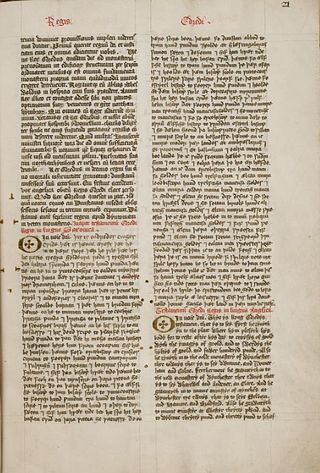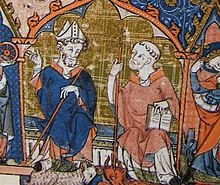
Dunstan, OSB was an English bishop. He was successively Abbot of Glastonbury Abbey, Bishop of Worcester, Bishop of London and Archbishop of Canterbury, later canonised. His work restored monastic life in England and reformed the English Church. His 11th-century biographer Osbern, himself an artist and scribe, states that Dunstan was skilled in "making a picture and forming letters", as were other clergy of his age who reached senior rank. Dunstan served as an important minister of state to several English kings. He was the most popular saint in England for nearly two centuries, having gained fame for the many stories of his greatness, not least among which were those concerning his famed cunning in defeating the Devil.

Eadwig was King of England from 23 November 955 until his death. He was the elder son of Edmund I and his first wife Ælfgifu, who died in 944. Eadwig and his brother Edgar were young children when their father was killed trying to rescue his seneschal from attack by an outlawed thief on 26 May 946. As Edmund's sons were too young to rule he was succeeded by his brother Eadred, who suffered from ill health and died unmarried in his early 30s.

Edward the Martyr was King of the English from 8 July 975 until he was killed on 18 March 978. He was the eldest son of King Edgar (959–975). On Edgar's death, the succession to the throne was contested between Edward's supporters and those of his younger half-brother, the future King Æthelred the Unready. As they were both children, it is unlikely that they played an active role in the dispute, which was probably between rival family alliances. Edward's principal supporters were Dunstan, Archbishop of Canterbury and Æthelwine, Ealdorman of East Anglia, while Æthelred was backed by his mother, Queen Ælfthryth and her friend Æthelwold, Bishop of Winchester. The dispute was quickly settled. Edward was chosen as king and Æthelred received the lands traditionally allocated to the king's eldest son in compensation.

Edgar was King of the English from 959 until his death. He became king of all England on his brother's death. He was the younger son of King Edmund I and his first wife Ælfgifu. A detailed account of Edgar's reign is not possible, because only a few events were recorded by chroniclers and monastic writers were more interested in recording the activities of the leaders of the church.

Pershore Abbey, at Pershore in Worcestershire, was an Anglo-Saxon abbey and is now an Anglican parish church, the Church of the Holy Cross.

Abbo or Abbon of Fleury, also known as Saint Abbo or Abbon, was a monk and abbot of Fleury Abbey in present-day Saint-Benoît-sur-Loire near Orléans, France.
Æthelgar was Archbishop of Canterbury, and previously Bishop of Selsey.

Æthelwold of Winchester was Bishop of Winchester from 963 to 984 and one of the leaders of the tenth-century monastic reform movement in Anglo-Saxon England.

Oscytel was a medieval Bishop of Dorchester and Archbishop of York.
Ealdwulf was a medieval Abbot of Peterborough, Bishop of Worcester, and Archbishop of York.
Æthelstan Half-King was an important and influential Ealdorman of East Anglia who interacted with five kings of England, including his adopted son King Edgar the Peaceful. Many of Æthelstan's close relatives were also involved in important affairs, but soon after the death of King Eadred in 955, he left his position and became a monk at Glastonbury Abbey.
Koenwald or Cenwald or Coenwald was an Anglo-Saxon Bishop of Worcester, probably of Mercian origin.

The Regularis Concordia was the most important document of the English Benedictine Reform, sanctioned by the Council of Winchester in about 973.

Eadnoth the Younger or Eadnoth I was a medieval monk and prelate, successively Abbot of Ramsey and Bishop of Dorchester. From a prominent family of priests in the Fens, he was related to Oswald, Bishop of Worcester, Archbishop of York and founder of Ramsey Abbey. Following in the footsteps of his illustrious kinsman, he initially became a monk at Worcester. He is found at Ramsey supervising construction works in the 980s, and around 992 actually became Abbot of Ramsey. As abbot, he founded two daughter houses in what is now Cambridgeshire, namely, a monastery at St Ives and a nunnery at Chatteris. At some point between 1007 and 1009, he became Bishop of Dorchester, a see that encompassed much of the eastern Danelaw. He died at the Battle of Assandun in 1016, fighting Cnut the Great.
Ælfhere was Ealdorman of Mercia. His family, along with those of Æthelstan Half-King and Æthelstan Rota, rose to greatness in the middle third of the 10th century. In the reign of Edward the Martyr, Ælfhere was a leader of the anti-monastic reaction and an ally of Edward's stepmother Queen Dowager Ælfthryth. After the killing of Edward by Ælfthryth's servants in 978, Ælfhere supported the new king, Ælfthryth's son Æthelred the Unready, and was the leading nobleman in the Kingdom of England until his death in 983.
Æthelwine was ealdorman of East Anglia and one of the leading noblemen in the kingdom of England in the later 10th century. As with his kinsmen, the principal source for his life is Byrhtferth's life of Oswald of Worcester. Æthelwine founded Ramsey Abbey in 969, and Byrhtferth and Ramsey Abbey remembered him as Dei amicus, but the monks of nearby Ely saw him as an enemy who had seized their lands.
Æthelstan Mannessune was a landowner and monastic patron in late 10th-century Anglo-Saxon England, coming from a family of secularised priests. Remembered by Ely Abbey as an enemy, he and his family endowed Ramsey Abbey and allegedly provided it with a piece of the True Cross. His children became important in their own right, one of them, Eadnoth, becoming Abbot of Ramsey and Bishop of Dorchester, and another becoming abbess of Chatteris nunnery.
Germanus was a medieval English abbot and Benedictine monk. He travelled to Rome in about 957 and became a monk at Fleury Abbey in France. Back in England by 964 he served as a monastic official before being named abbot of Winchcombe Abbey in about 970, a position he was removed from in 975. Germanus may have become abbot of Cholsey Abbey in 992.

The English Benedictine Reform or Monastic Reform of the English church in the late tenth century was a religious and intellectual movement in the later Anglo-Saxon period. In the mid-tenth century almost all monasteries were staffed by secular clergy, who were often married. The reformers sought to replace them with celibate contemplative monks following the Rule of Saint Benedict. The movement was inspired by Continental monastic reforms, and the leading figures were Dunstan, Archbishop of Canterbury, Æthelwold, Bishop of Winchester, and Oswald, Archbishop of York.

Ælfwynn or Ælfwyn was a member of a wealthy Anglo-Saxon family in Huntingdonshire who married Æthelstan Half-King, the powerful ealdorman of East Anglia, in about 932. She is chiefly known for having been foster-mother to the future King Edgar the Peaceful following his mother's death in 944, when he was an infant. She had four sons, and the youngest, Æthelwine, became the chief secular magnate and leading supporter of the monastic reform movement. Ælfwynn donated her estates for his foundation of Ramsey Abbey in 966 and was probably buried there.











